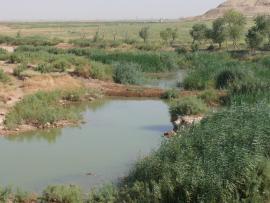The Humanities without Walls Consortium supports research at the University of Chicago, the University of Michigan, and Purdue University to study the social respose to climage change in antiquity.
The Humanities Without Walls consortium, which is funded by a grant from the Andrew W. Mellon Foundation and is based at the Illinois Program for Research in the Humanities, awarded approximately $136,000 over the course of three years (2018-2020) through the Franke Institute for the Humanities (the consortium's partner institution at the University of Chicago) to the project “Coping with Changing Climates in Early Antiquity: Comparative Approaches between Empiricism and Theory” —a collaborative endeavour from researchers at the University of Chicago, the University of Michigan and Purdue University. The project will investigate in a comparative perspective the social and cultural perceptions of, and experiences with, climate change in the Bronze and Early Iron Ages (third to first millennium BCE), through a multidisciplinary approach that convenes archaeologists, bioarchaeologists and text specialists focusing on three key geographic areas: Egypt and Nubia; the Eastern Mediterranean and Anatolia; and Mesopotamia.
Fostering interdisciplinary collaboration between the three partner institutions and between faculty and graduate students, the project will use ancient texts, archaeological and paleoenvironmental data (including ancient skeletal remains), and geospatial analysis to address a set of interrelated research questions:
- What kind of societal change can actually be identified at a fine-grained level of analysis (local/regional scale and decadal/centennial time frame) for the periods usually associated with episodes of abrupt climate change and civilizational collapse (such as the ‘4.2ka event’ that allegedly brought an end to the Akkadian Empire in Mesopotamia and the Old Kingdom in Egypt around 2200 BCE, or the ‘Late Bronze Age crisis’ around 1200 BCE that saw the demise of the Egyptian New Kingdom, Mycenaean Greece, the Hittite empire and several city-states in the Eastern Mediterranean)?
- Can similar or divergent patterns of change, response, and adaptation be identified, for these periods, between and within the three regions?
- Given that ‘abrupt’ climatic episodes often span decades, if not centuries, was there any perception by the members of ancient societies that the climate around them (environmental, but by extension, the social and political) was changing? What were the modes of representation or cultural forms with which they expressed these perceptions?
- Do the material, environmental, skeletal, and textual records attest to changes in practice or lifestyle (political system, habitat, dietary practices, mobility, etc.) that could be understood as responses to or experiences with these perceived environmental shifts? In what ways were these changes driven (or imposed) by the socio-political elites, as opposed to the agency or resilience of small communities, households or even
By its interdisciplinary nature, the project will allow graduate students to broaden the scope of their interests and engage in a dialogue with other collaborators (faculty and students alike) whose field of expertise differs from their own, helping shape new paths for collaborative practices in the Humanities along the way.
Assistant Professor of Assyriology and P.I. Hervé Reculeau, from the Oriental Institute, the Department of Near Eastern Languages and Civilization and the College at the University of Chicago will study how Assyrians adapted during the Late Bronze Age (15th-12th c. BCE) to newly conquered environments in the context of a slowly degrading climate, and how the strategies they developed impacted their response to the crisis that marked the end of the period. He and Jay Crisostomo, Assistant Professor of Assyriology from the Department of Near Eastern Studies at the University of Michigan, will address the cultural implications of (changing) climate(s) as apparent in the textual records of Mesopotamia (Sumerian, Babylonian and Assyrian). Bioarchaeologists Michele Buzon, Professor of Anthropology at Purdue University, and Katie Whitmore will analyze human skeletal remains from Egypt and Nubia (modern Sudan), focusing on Egyptian-Nubian entanglement (both cultural and biological) as people cope with and adapt to the changing political/cultural landscape. They will be joined by Nadine Moeller, Associate Professor of Egyptian Archaeology at the University of Chicago, and Émilie Sarrazin, who will use new archaeological data from the ongoing excavations at two ancient Egyptian settlements (Tell Edfu and Dendera) to investigate the patterns of climatic, political and cultural changes and responses by the ancient populations. Gary Beckman, the George C. Cameron Professor of Ancient Near Eastern Languages and Cultures at the University of Michigan, will address the perception of environment and climate in Hittite culture and religion and collaborate with fellow Hittitologists Thalia Lysen (Chicago) and Timothy Leonard (Michigan) on the study of the assumed role of climatic degradation in the demise of the Hittite empire and its Syrian vassal city-states at the end of the Late Bronze Age. Finally, Catherine Kearns (Assistant Professor in Classics at the University of Chicago) will address patterns of climatic change, shifts in agropastoral economies, and new political formations in the context of semiarid insular environments on Cyprus, combining spatial analyses with archaeological fieldwork on rural settlements of the early first millennium BCE.


